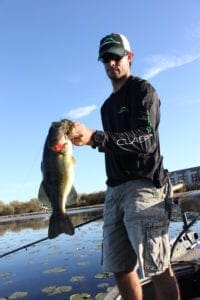For many bass tournament anglers the acronym KISS (keep it simple sir) always plagues their mind, when the bite isn’t going the way they had hoped. This is why it is important for all bass anglers to have a good understanding of the three key rigs that should be used when chasing bass.
The first rig that many bass anglers use in their infancy of bass fishing is the Texas-rig, mainly because of its ability to fish heavy cover and not get snagged and also its versatility. The Texas-rig consists of three main components, the weight, hook and plastic bait. Above, we mentioned how versatile the Texas-rig, this is because by changing up the bait and weight you use, you can do so many things with it.
By upping your weight to a ½ oz or larger Tungsten weight, you can probe deep water cover or punch through the thickest of mats. Or by, putting a very small split shot or 1/16 oz weight on, you can let your plastic bait drift in the current or swim it over the top of vegetation.
The vast array of soft plastic baits on the market make great options for Texas-rigging, from tubes to craws, to lizards and worms, there is a shape, size and color that will work for your favorite body of water.
With a Texas-rig you can target any form of fish holding cover, from pitching it to weed edges or clumps or around stumps and laydowns, the Texas-rig is a definite must know rig for any bass fisherman.
A Carolina-rig is a great technique for anglers to use to target deep water structure that is holding bass. A C-Rig as it is commonly referred to, is also a great way to determine what the bottom content is and what structure is available on the bottom of the lake, which is why tossing a Carolina rig, is a great way to dredge the depths of any body of water.
Some of the offshore structure that a C-Rig shines around is underwater humps, wood, points and breaks. By adapting the components that make up a Carolina-rig, an angler can employ this technique in situations on their local body of water, whether it is a deep lake or a shallow river. Another benefit of using a C-Rig is that it is an effective lure to cover a vast amount of water in a short amount of time.
The components of a Carolina-rig consist of a main line that is usually Fluorocarbon (15 lb), then a Fluorocarbon leader, which can range from 12 to 36 inches in length. A brass or tungsten weight gets threaded on to the line first; the size of the weight is usually in the 3/8 to 1 oz range, depending on how deep of water is. Following the weights is a bead or two, these help protect the knot from damage and also create noise when they make contact with the weight and then a high quality ball bearing swivel that connects the main line to leader.
Now on the business end of my C-Rig is an extra wide gap hook, with some form of plastic bait on it, such as a baby creature bait, ring fry, stickbait or Fluke.
When it comes to hook selection for your Texas or Carolina rig, you’ll want to use a hook that has a big enough gap so the plastic has room to move when you set the hook, thus giving you a solid hook up on that big bass. Depending on the size of your plastic bait and shape, you’ll either want to use an extra wide gap hook or round bend hook.
A technique that has become quite popular over the past ten years or so is drop shoting. To rig your drop shot, first take your 1/0 or size 1 drop shot hook and tie a Palomar knot. Then, instead of cutting the tag end off, run it back through your hook eye and take a drop shot weight and clip it on the tag line where you want your dropper to end.
When selecting your weight, try to use the smallest weight possible. This will depend on the water depth, wind and current. The majority of the time, a 3/16 oz round or cylinder shaped drop shot weight is a good starting point.
Top choices for plastics for drop shoting include wacky-rigged stickbaits, nose hooked finesse worms or small swimbaits. Deciding on which bait to use has a lot to do with what the bass are feeding on in the lake or river you are fishing. If they are feeding on minnows then I want my bait to resemble a minnow. If the bass are very lethargic, then I’ll use a small plastic bait such as a small worm or 3” wacky rigged soft plastic stickbait, these baits will make any bass bait despite how tough the conditions are.
With these three simple to rig bass fishing set ups, you’ll be able to effectively target bass on any body of water, regardless of water depth, cover or time of year. So next time you are looking to practice up on a new technique, don’t forget about them!


















